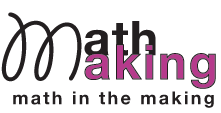Research Findings
Through the iterative design, testing, and reflection process, the project team identified several design principles for supporting the authentic integration of mathematical engagement into making activities. These emergent design principles provide initial guidance for educators looking to integrate mathematics into making activities. They also suggest further research to test and expand these principles across a variety of learning contexts.
(1) Curate materials to highlight salient mathematical relationships
The careful selection of materials can shape opportunities for mathematical thinking and conversation, make key variables more salient, enable comparisons and highlight relationships, and create natural design constraints. Having a limited selection of materials that differ in careful ways can create opportunities for mathematical contrast. For example, in the CMP weaving activity, educators made yarns of very different thicknesses available so that it would become obvious how those thicknesses affected the length of the resulting piece.
(2) Tailor design choices so that mathematical issues are more likely to emerge
Constraints are a “maker-friendly” way of helping visitors attend to mathematical aspects of the design activity. Careful selection of design options is one approach to constraints that can encourage deeper mathematical thinking and conversations. In a making context, it is important that visitors have some choice over the design constraints. Educators can provide opportunities for different constraint decisions (e.g., the shape of the weaving loom) that have known mathematical implications (e.g., thinking about the length of rows involved in weaving a diagonal line). For example, in the CMP weaving activity, educators created pre-made, non-rectangular looms. These looms require careful mathematical planning because each row may need a different number of over-under pairs than the previous one.
(3) Highlight mathematical quantities that are consequential to the making.
Highlighting quantities that can take on different values (e.g., different wheel diameters, different thickness of yarn) can provide a natural opportunity for visitors to compare results of making these design choices. Promising approaches to highlighting variables include curating the design options (e.g., loom shapes), curating the materials (e.g., different wheels), and providing mathematical design affordances (e.g., ruler or grid). In the NYSCI mask-making workshop, the dimension of participants’ faces was a natural quantity to highlight as critical for creating properly fitting masks.
(4) Incorporate materials and cues that visitors may see as math related
Visitors (and staff) have very different ideas about what counts as mathematics—both in general and in a maker activity. Math cues that suggest that the context is mathematical by leveraging visitor stereotypes about math (e.g., shapes, numbers, grids, measuring tools) may be a useful way of helping visitors connect the experience with math—and more importantly, to expand their ideas about themselves as mathematical thinkers. For example, the fabric patterns used in the NYSCI clothing design activity and the measuring tape provided during the mask-making workshop both seemed to encourage visitors to relate their experiences to math. Math cues also likely influence facilitators and educators, shaping how they frame the experiences for participants.
The research process also raised important questions about what is meant by “authentic integration” of math and making. To learn more about the team’s reflections related to this topic, see the article in TERC’s Hands On! publication.
